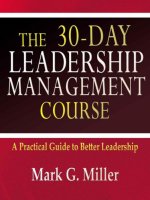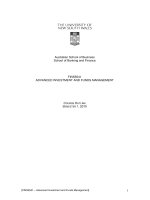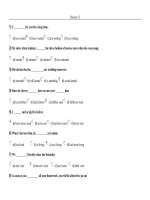Final exam management COURSE
Bạn đang xem bản rút gọn của tài liệu. Xem và tải ngay bản đầy đủ của tài liệu tại đây (116.27 KB, 5 trang )
Emirates International University
Faculty of Administration and
Finance
Academic Year 2020-2021
First Semester
الجامعة الماراتية الدولية
كلية العلوم الدإارية والمالية
م2021-2020 العام الدراسي
الفصل الدراسي الول
Final Examination (Questions Sheet)
:Department:
Course No:
:Level
: Part
Model No:
Student Name
Course Name: Management
One: The MCQ Questions ( 1.5 Mark each Question)
Q1 Management involves ________.
a. coordinating and overseeing the work activities of others
b. dividing a market into distinct groups of buyers who have different needs, characteristics, or
behaviors, and who might require separate products or marketing programs
c. turning marketing plans into marketing actions to accomplish strategic marketing objectives
d. so that their activities are completed efficiently and effectively.
Q2 Efficiency is defined as :
A) “Doing things right” Getting the most output for the least inputs
B) Effectiveness
C) “Doing the right things”
D) wants
Q3 Functions Manager’s Perform consists of :
A) planning , coordinating , place
B) planning, organizing , controlling , leading
C) planning, organizing
D) controlling , leading
Q4 Management Roles are :
A) Interpersonal roles ,Informational roles , Decisional roles
B) Figurehead, leader, liaison
C) supply-chain analysis
D) price discrimination
Q5 Skills Managers Need are :
a. Technical skills ,Human skills ,Conceptual skills
b. Human skills ,Conceptual skills
c. Conceptual skills
d. Culture ,social , and personal factors
1
Emirates International University
Faculty of Administration and
Finance
Academic Year 2020-2021
First Semester
الجامعة الماراتية الدولية
كلية العلوم الدإارية والمالية
م2021-2020 العام الدراسي
الفصل الدراسي الول
Q6 Much of an organization’s success or failure are due to :
a. External forces outside of managers’ control
b. Connections with Government
c. Connections with Marketing Partners
d. Connections with the World Around Us
Q7 Organizational Culture is :
a. A system of shared meanings and common beliefs held by organizational members
b. that determines, in a large degree, how they act towards each other b. globalization.
c. social consciousness.
d. privatization
Q8 Dimensions of organizational :
a. Attention to Detail.
b. Outcome Orientation
c. Aggressiveness
d. (a,b, c)
Q9 Of the Factors Influencing the Strength of Culture are :
a. Size of the organization
b. Age of the organization
c. Rate of employee turnover
d. (a,b, c)
Q10 Of the Sources of Organizational Culture:
a. The organization’s founder: vision and mission
b. Past practices of the organization :the way things have been done
c. The behavior of top management
d. (a,b, c)
Q11 Employees Learn Culture through :
a. rituals
b. stories
c. Materials symbols
d. (a,b, c)
Q12 Decision is defined as :
a. “Making a choice from two or more alternatives.”
b. “Location, location, location.”
c. “Watch your costs at all cost.”
d. “An overall evaluation of the company’s strengths, Weaknesses , Opportunities
and Threats
Q13 Problem is defined :
a. Identifying a problem and decision criteria and allocating weights to the criteria
b. A discrepancy between an existing and desired state of affairs
c. production cost concept
2
Emirates International University
Faculty of Administration and
Finance
Academic Year 2020-2021
First Semester
الجامعة الماراتية الدولية
كلية العلوم الدإارية والمالية
م2021-2020 العام الدراسي
الفصل الدراسي الول
d. marketing concept
Q14 Of the Decision-Making Process :
a. suppliers
b. Identifying a problem and decision criteria and allocating weights to the criteria
c. company internal environment
d. society
Q15Of the Characteristics of Problems:
a. Microenvironment force (public )
b. There is pressure to solve the problem
c. A problem becomes a problem when a manager becomes aware of it.
d. (b and c )
Q16 Decision criteria are factors that are :
a. microenvironment force (public )
b. important(relevant) to resolving the problem
c. relationship channel
d. economic factors that affect consumer buying power and spending patterns
Q17 After developing alternatives , we :
a. Analyze alternatives
B) Create basic relationships
C) make causal relationships
D) do club marketing programs
Q18 In Implementing the Alternative:
a. We choose the best choice of several choices
b. Put the chosen alternative into action
c) customized marketing
d inventory management
Q19 In Evaluating the Decision’s Effectiveness
a. The soundness of the decision is judged by its outcomes
b. Differentiated marketing and undifferentiated marketing strategies
c. Supply chain management
d. economic factors that affect consumer buying power and spending patterns
Q20 Selecting an Alternative
a. We choose the best choice if several choices
b. Evaluate the solutions after the problem is solved
c. TQM
d. Management
3
Emirates International University
Faculty of Administration and
Finance
Academic Year 2020-2021
First Semester
: Part Two:
الجامعة الماراتية الدولية
كلية العلوم الدإارية والمالية
م2021-2020 العام الدراسي
الفصل الدراسي الول
The True/False Questions (2 Mark each Question)
Q1. Taylor’s Scientific Management Principles includes :Developing a science
for each element of an individual’s work, which will replace the old rule-ofthumb method
- T
-f
Q2. Quantitative Approach : is evolved from mathematical and statistical
methods developed to solve military logistics and quality control problems
- T
-f
Q3. Coordination of the organization’s parts is not essential for proper
functioning of the entire organization
- T
-f
Q4. Popular Contingency Variables includes statistical approach
,total quality management etc.
- T
-f
Q5. Allocating Weights to the Criteria is the one step of taking
decision process
- T
-f
Q6. Stories are : narratives of significant events or actions of people
that convey the spirit of the organization
- T
-f
Q7. External Environment are those factors and forces outside the
organization that affect the organization’s performance
- T
-f
Q8. Implications of organizational culture includes :
Culture is a perception.
Culture is shared.
Culture is descriptive
- T
-f
Q9. The ability of managers to affect outcomes is influenced and
constrained by external factors
T
-f
Q10. The quality of the organization is determined by the quality
of its managers
- T
-f
4
Emirates International University
Faculty of Administration and
Finance
Academic Year 2020-2021
First Semester
:Lecturer
الجامعة الماراتية الدولية
كلية العلوم الدإارية والمالية
م2021-2020 العام الدراسي
الفصل الدراسي الول
Name:
Signature
5









